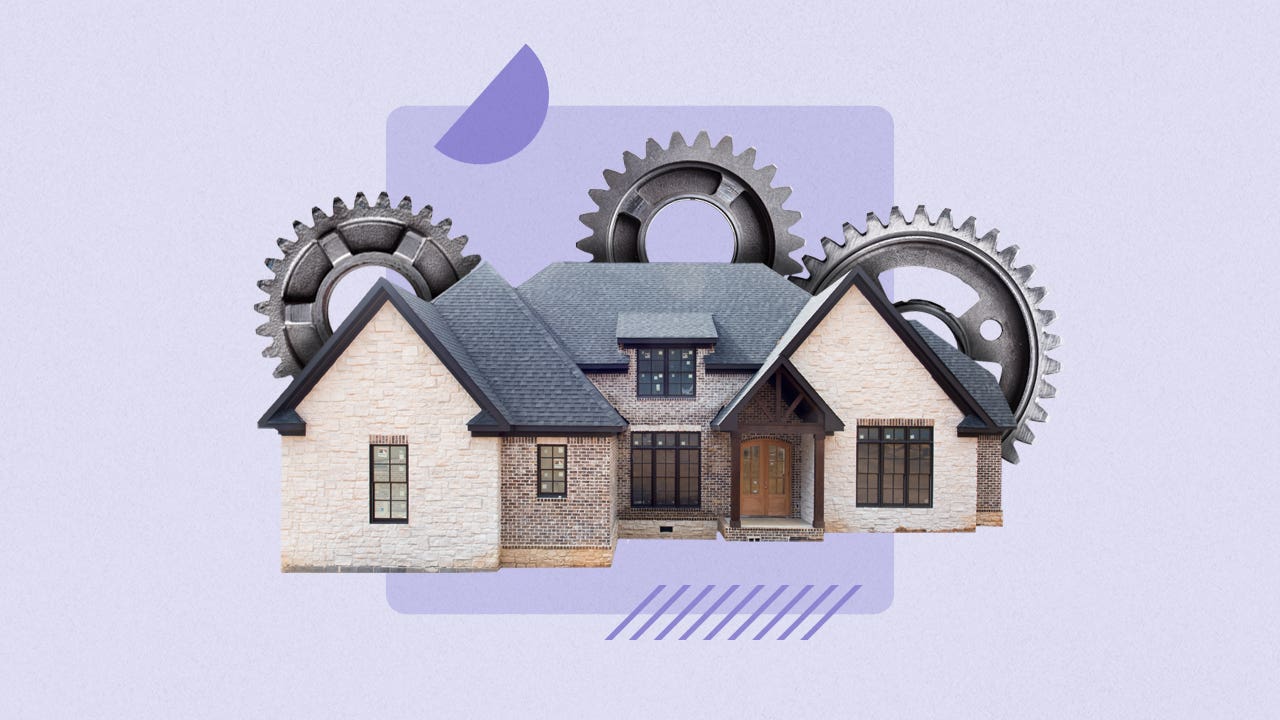
Pros and cons of an adjustable-rate mortgage (ARM)
Key takeaways
- An adjustable-rate mortgage (ARM) is a mortgage whose interest rate resets at periodic intervals.
- ARMs have low fixed interest rates at their onset, but often become more costly after the rate starts fluctuating.
- ARMs tend to work best for those who plan to sell the home before the loan’s fixed-rate phase ends. Otherwise, they’ll need to refinance or be able to afford periodic jumps in payments.
If you’re in the market for a home loan, one option you might come across is an adjustable-rate mortgage. These mortgages come with fixed interest rates for an initial period, after which the rate moves up or down at regular intervals for the remainder of the loan’s term.
This type of mortgage can be a more affordable means to get into a home, especially when higher rates on fixed mortgages are beginning to price some borrowers out. But is it worth the risk of unknown and potentially larger payments in the future? Here’s how to know if you should get an adjustable-rate mortgage.
Adjustable-rate mortgage pros and cons
There are benefits and drawbacks to consider before deciding if an adjustable-rate mortgage (ARM) is right for you. Let’s break down some of the points you should consider.
Pros of an adjustable-rate mortgage
- Lower introductory rate and monthly payments: An ARM often comes with a lower initial interest rate than that of a comparable fixed-rate mortgage, giving you lower monthly payments — at least for the loan’s fixed-rate period. If you’re planning to sell before the fixed period is up, an ARM can save you a bundle on interest.
- Monthly payments might decrease: If prevailing market interest rates have gone down at the time your ARM resets, your monthly payment will also fall. (However, some ARMS do set interest-rate floors, limiting how far the rate can decrease.)
- Could be good for investors: An ARM can be appealing for investors who want to sell before the rate adjusts, or who will plan to put their savings on the interest into extra payments toward the principal.
Cons of an adjustable-rate mortgage
- Monthly payments might increase: The biggest disadvantage of an ARM is the likelihood of your rate going up. If rates have risen since you took out the loan, your payments will increase when the loan resets. Often, there’s a cap on the rate increase, but it can still sting and eat up more funds that you could use for other financial goals.
- Need a plan for resets: If you intend to keep the mortgage past that first rate reset, you’ll need to plan for how you’ll afford higher monthly payments long-term. If you end up with an unaffordable payment, you could default, harm your credit and ultimately face foreclosure.
- More complicated to prepay: Unlike a fixed-rate mortgage, adding extra to your monthly payment won’t drastically shorten your loan term. This is because of how ARM interest rates are calculated. Instead, prepaying like this will have more of an effect on your monthly payment. If you want to shorten your term, you’re better off paying in a large lump sum.
Keep in mind: Your monthly payments are guaranteed to go up if you opt for an interest-only ARM. With this type of loan, you’ll pay only interest for a set period of time. When that ends, you’ll pay both interest and principal. This bigger bite out of your budget could negate any interest savings if your rate were to adjust down.
Who is an adjustable-rate mortgage best for?
Adjustable-rate mortgages can be advantageous in certain situations. Here are a few examples:
- You don’t plan to stay in the home for a long time. If you know you’re going to sell a home within five to 10 years, you can opt for an ARM, taking advantage of its lower rate and payments, then sell before the rate can adjust.
- You plan to refinance. If you expect rates to drop before your ARM rate resets, taking out at ARM now, and then refinancing to a lower rate at the right time could save you a considerable sum of money.
- You’re starting your career. Borrowers soon to leave school or early in their careers who know they’ll earn substantially more over time might also benefit from the initial savings with an ARM. Ideally, your rising income would offset any payment increases.
- You’re comfortable with the risk. If you’re set on buying a home now with a lower payment to start, you might simply be willing to accept the risk that your rate and payments could rise down the line, whether or not you plan to move. “A borrower might perceive that the monthly savings between the ARM and fixed rates is worth the risk of a future increase in rate,” says Pete Boomer, president and CEO of Arvest Bank’s mortgage division.
- You’re taking out ajumbo loan. Borrowers taking out bigger loans tend to take up ARMs. A recent CoreLogic analysis found that, as of April 2023, ARMs comprised 45 percent of the dollar volume of mortgage originations exceeding $1 million, a six percentage-point increase from April 2022. Such jumbo loans usually have higher interest rates, as more money is at risk; so, every little break helps.
- You’re able to make extra payments in the introductory period. If you have room in your budget to pay extra toward the loan principal during the initial rate period, a lower-rate ARM can help you maximize those interest savings. (Bankrate’s additional mortgage payment calculator can help you weigh different scenarios.)
Why ARMs are popular right now
At the beginning of 2022, very few borrowers were bothering with ARMs — they accounted for just 3.1 percent of all mortgage applications in January, according to the Mortgage Bankers Association (MBA).
Fast-forward to July 2024, and that figure has nearly doubled to 6 percent. (It actually was higher over the past year — ARMs accounted for 8.8 percent of new mortgages the week of Nov. 15, 2023, MBA reports.)
The increase is directly related to the rise in fixed mortgage rates, which were nearing 8 percent last fall, a level not seen since 2000. With less purchasing power at higher fixed rates, the lower introductory rates attached to ARMs have started to look much more appealing.
“Given still-high home prices and this rising rate environment, potential homebuyers are finding ways to reduce their monthly payments and view ARMs as more attractive,” says Joel Kan, MBA’s vice president and deputy chief economist. In the recent past, ARMs have charged as much as a full percentage point less than fixed mortgages. And of course, they offer a chance to ride a reduction in rates.
ARMs tend to be more popular with younger, higher-income households with bigger mortgages, according to the Federal Reserve Bank of St. Louis. Nearly 19 percent of households in the top income decile have ARMs compared with just 6.5 percent in the bottom income decile. One explanation is that higher-income households are more able to absorb the risk of higher payments when interest rates increase, while lower-income households may be unable to afford their mortgage if rates go up. Younger borrowers (the median ARM-holder’s age is 32) also have the time and potential earning power to weather the ups and downs of interest-rate trends, in contrast to middle-aged borrowers beginning to think about retirement.
The risk of ARMs
It can be more difficult to qualify for an ARM compared to a fixed-rate mortgage because you’ll need a higher down payment of at least 5 percent, versus 3 percent for a conventional fixed-rate loan.
There’s also the need to verify that your current finances can accommodate a higher payment down the road — even if you plan to move before the lower-rate period ends.
“Most ARM loans now are underwritten based on the highest payment expected on the loan to ensure the borrower can handle the payment shock from a rate increase,” says Kan. “Many other factors come into play, such as rates over the longer five- to 10-year horizon, the borrower’s income and employment situation, and housing market conditions that impact their ability to refinance or sell (if necessary) when their fixed period expires.”
That “if necessary” piece underscores the primary risk with ARMs: It’s impossible to predict the future. If you need a stable monthly payment — or simply can’t tolerate any level of risk — it’s best to go with a fixed-rate mortgage, despite the expense.
Other loan types to consider
Along with ARMs, you should consider a variety of loan types. Some may have a more lenient down payment requirement, lower interest rates or lower monthly payments than others. Options include:
- 15-year fixed-rate mortgage: If it’s the interest rate you’re worried about, consider a 15-year fixed-rate loan. It generally carries a lower rate than its 30-year counterpart. You’ll make bigger monthly payments but pay less in interest and pay off your loan sooner.
- 30-year fixed-rate mortgage: If you want to keep those monthly payments low, a 30-year fixed mortgage is the way to go. You’ll pay more in interest over the longer period, but your payments will be more manageable.
- Government-backed loans: If it’s easier terms you crave, FHA, USDA or VA loans often come with lower down payments and looser qualifications.
FAQ about adjustable-rate mortgages
-
An adjustable-rate mortgage (ARM) has an initial fixed interest rate period, typically for three, five, seven or 10 years. Once that period ends, the interest rate adjusts at preset times for the remainder of the loan term. Your new monthly payment can rise or fall along with the general mortgage rate trends. Often, the rates on ARMs are tied to the yield on one-year Treasury bills, the 11th District cost of funds index (COFI) or an index called the Secured Overnight Financing Rate (SOFR). The rate you pay will be the rate of the index at the time of the reset plus a margin set by the lender.
-
Most mortgage lenders offer both fixed- and adjustable-rate loans, though the offerings and terms vary greatly. Lenders provide weekday mortgage rates to Bankrate’s comprehensive national survey, which shows the latest marketplace average rates for various purchase loans, including current adjustable-rate mortgage rates.



